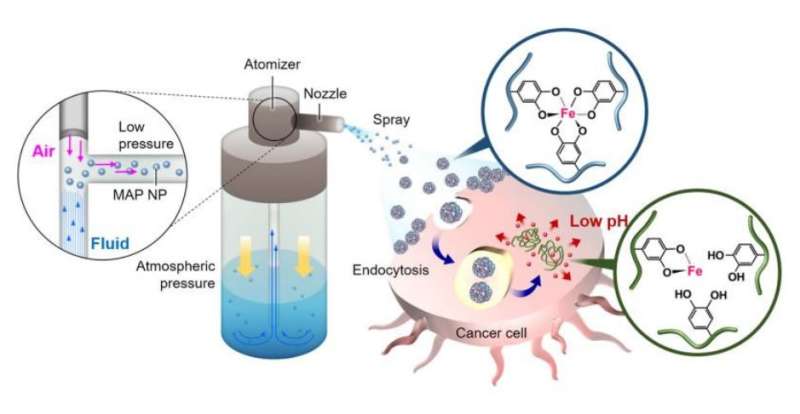August 14, 2018 feature
Chemo spray may offer alternative to conventional chemotherapy

Chemotherapy is often used as a follow-up treatment after surgical removal of a cancerous tumor in order to destroy any remaining cancer cells, but intravenous chemo drugs have notorious side effects and are not always effective.
In a new study, researchers have developed what is basically a "chemo spray" – a chemotherapy drug such as doxorubicin that is encapsulated in nanoparticles and can be sprayed directly onto the tissue surface near the tumor site. Due to the chemical composition of the nanoparticles and cancer cells, the nanoparticles are efficiently taken in primarily by cancer cells and drug release is triggered by the chemical environment inside the cancer cells. Compared to conventional intravenous chemotherapy, the topical spray promises to offer a lower risk of systemic toxicity and better therapeutic effects.
The researchers, led by Hyung Joon Cha at Pohang University of Science and Technology in South Korea, have published a paper on the sprayable cancer therapy in a recent issue of ACS Nano.
The researchers had to overcome several challenges in order to develop the nanoparticle-based chemo spray. One of the first was to find a way for the nanoparticles to stick to the outside of the tumor cells, which are surrounded by bodily fluids. In general, it's very difficult to design nanoparticles that are capable of adhering to solid surfaces in aqueous environments.
To address this problem, the researchers turned to marine mussels, which produce a special "mussel glue" in order to stick to wet rocks under harsh seawater conditions. Recent research has shown that this glue, which consists of mussel adhesive proteins (MAPs), may serve as a bioadhesive material for biomedical applications. Due to the limited availability of natural MAPs, in the current study the researchers used a bioengineered form of MAPs, which they showed enables the nanoparticles to adhere to porcine skin tissue surfaces in aqueous conditions for more than a month.
In addition to helping the nanoparticles stick, the MAPs also contain components that allow the drug-carrying nanoparticles to enter and destroy cancer cells, while bypassing healthy cells. One reason for a higher cellular uptake of the nanoparticles into cancer cells is the higher metabolic rates of cancer cells compared to normal cells. In addition, cancer cells also have negatively charged surfaces, and MAPs contain positively charged residues, causing an attraction between the nanoparticles and cancer cells.
The nanoparticles typically enter the cancer cells through a cellular uptake process such as endocytosis, after which they are transported to the cell's nucleus. When exposed to the acidic environment of organelles called endolysosomes, the nanoparticles receive the trigger to release their cargo, such as doxorubicin or other anticancer drug. Because the drug release is pH-responsive, the highly toxic drugs remain encapsulated in the nanoparticles until they reach the endolysosome in the cancer cells, generally leaving other parts of the body unharmed.
The sprayable treatment also offers a second kind of anticancer agent, an amino acid called DOPA that comes from the bioengineered mussel glue. Besides playing a key role in surface adhesion, DOPA also depletes the iron (Fe3+) in cancer cells. As iron promotes cancer cell proliferation, its depletion helps to further weaken the cancer cell and eventually leads to apoptosis (cell death).
"The mussel adhesive protein-based sprayable sticky nanoparticles not only facilitate site-directed administration of drugs via a convenient spraying process during the surgical procedure, but also induce an effective anticancer effect based on the significantly enhanced drug retention and absorption efficiency in the cancerous lesion," Cha told Phys.org. "Therefore, our nanoparticle-based localized drug delivery system can compensate for the disadvantages of low drug delivery efficiency and systemic toxicity in systemic delivery system."
In the future, the researchers plan to investigate ways to extend the spray method to different types of therapies to treat a wide variety of diseases.
"In this research, we applied sprayable adhesive nanoparticles onto tissue surfaces using an air-pressured atomizer," Cha said. "We plan to expand therapeutic applications depending on spray types such as endoscopic or laparoscopic spray for various cancer treatments. In addition, we will develop a local delivery system for various therapeutic agents such as gene, peptide, or photothermal agents as well as other chemical drugs."
More information: Yeonsu Jeong et al. "Sprayable Adhesive Nanotherapeutics: Mussel-Protein-Based Nanoparticles for Highly Efficient Locoregional Cancer Therapy." ACS Nano. DOI: 10.1021/acsnano.8b04533
Journal information: ACS Nano
© 2018 Phys.org





















